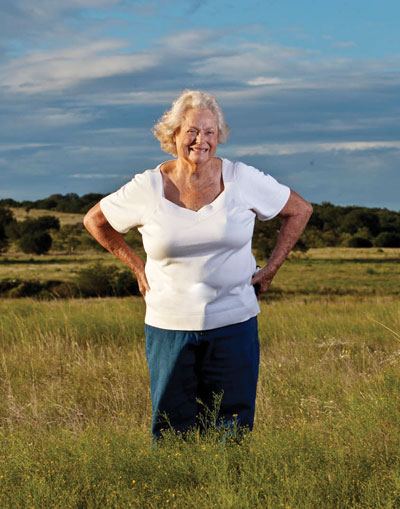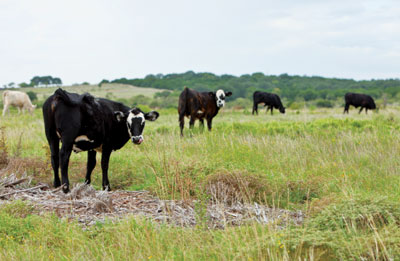
Wynona Winters on the T.E. Winters C Bar Ranch
Photo by Jim Lincoln
Driving through the sleepy Central Texas town of Lometa, you might get the impression that not much has changed here in a while. But between Lometa and Goldthwaite lies a three-generation ranching legacy that counts change as the very reason for its longevity. For the Winters family, seizing new opportunities has proven to be a smart strategy for holding on to the one venture that really matters — the ranch.
“The ranch” is the T.E. Winters C Bar Ranch in Mills County. Thomas Earl and Wynona Winters had been married only four years when they bought the original 3,000 acres in 1959 for $65 an acre.
The knack for seeing savvy diversification opportunities soon surfaced. “After we bought the ranch, Thomas Earl, dad T.W. Winters, brother David and several local businessmen decided to start the Lampasas Livestock Auction. It was the only one in the area, and it took off in a hurry,” says Wynona, whose husband died in 2006. “It was an opportunity for us to make some money, and gave us access to buy and sell a lot of cattle.”
Eventually the Winters family bought out the other investors, and while the two men ran the auction, she ran the ranch. “Thomas Earl would buy steer calves weighing 300 to 400 pounds. They would be over-stressed and sometimes get sick,” says Wynona, who managed as many as 500 head at times. “I’d ride through them on my horse and check to see if they were eating, cut the sick ones off from the rest, give them shots and get them well.” After 45-60 days, the cattle went to Kansas and on to feedlots.
Other Investments Help Pay the Bills
To help keep the ranch going and growing, the couple made a series of non-agricultural investments over the years. The first was a business in the Dallas-Fort Worth area. Later, when an opportunity arose to invest in a greyhound racetrack in Harlingen, Thomas Earl and Wynona once again took advantage of it. Later, they started a business in Killeen, which is managed by their daughter, Molly Winters. Meanwhile, grandson Marshall Winters manages the ranching operation.
Marshall and Molly each have a home on the ranch. The Winters’ other daughter, Maggy, and her husband, Craig Jones, and their three children also have a home on the property.
“Ranching just won’t do it all by itself; there’s no way we could have survived just on the ranch,” says Wynona. “These other investments helped us hang on to our land, keep the ranching operation going and buy quite a bit more land.”

Cattle have been the mainstay of the T.E. Winters C Bar Ranch since 1959. The Winters family is converting the cattle business to a natural grass-fed operation.
Photo by Jim Lincoln
Over the years, the family has seized several opportunities to purchase ranchland in the area. Today the C Bar encompasses 10,000 contiguous acres, financed in part through Farm Credit. “We discovered the Federal Land Bank in Brownwood (now part of Central Texas Farm Credit) in about 1980, when we needed to refinance a ranch mortgage loan. They had the best interest, about 6 percent less than we were paying with an insurance company. And, they are good, decent people to work with,” says Wynona.
Travis McKinney, president and branch manager of Central Texas Farm Credit’s Brownwood office, says the Winters’ ability to “think outside the box” and support their ranching operation with off-farm income is impressive. McKinney has taken care of most of the Winters’ financing needs for the past several years.
Converting to Natural-Grass Pastures
Their latest endeavor — converting the ranch to a natural grass-fed cattle operation — is a labor of love that will bring fundamental change to their operation. Wynona is banking on her investment in her brother’s massive Las Colinas entertainment complex to help make the conversion to grass-feeding possible. “I want to get the cattle off all the expensive feeds and chemicals and get the land back like it used to be,” she says, noting that she and Marshall already have cleared cedar and mesquite from nearly 1,000 acres.
The pair hopes to work with Texas Mesquite Fuels to expedite the land clearing. “They want to build electricity plants that run off cedar and mesquite,” she says. “They will clear your land in exchange for the wood that was cleared. That’s going to help with our groundwater, our grass, our deer hunting. We’ll have cleaner cattle, with less money in them.”
Clearing the land may take up to two years, and then it will be another 10 to 15 years before the ranch can be certified as organic. “There are so many benefits to intense grazing management,” says Marshall. “We can combine the herd and allow them to graze down to three inches, then move them to the next pasture and use sheep behind them to eat the weeds.
“We should be able to run a great deal more cattle on 10,000 acres, as opposed to 500 head now,” he says, estimating that a fat grass-fed steer can bring one-and-a-half times the price of a grain-fed steer.
“I know it is going to take a lot of time and money,” says Wynona, “and that is why I ventured into the Irving entertainment complex. We’ve worked hard for this place; it is the perfect place to live and raise a family, and we intend to keep it in the family for many generations.”
– Sue Durio